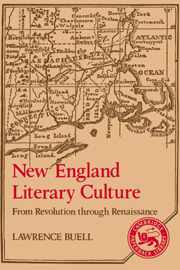Book contents
- Frontmatter
- Contents
- Acknowledgments
- Abbreviations of Frequently Cited Works
- PART I FOUR OVERVIEWS
- 1 Theoretical Premises
- 2 A Narrative Overview of New England's Literary Development
- 3 Marketplace, Ethos, Practice: The Antebellum Literary Situation
- 4 Neoclassical Continuities: The Early National Era and the New England Literary Tradition
- PART II THREE REPRESENTATIVE GENRES
- PART III REINVENTING PURITANISM: THE NEW ENGLAND HISTORICAL IMAGINATION
- Part IV NEW ENGLAND AS A COUNTRY OF THE IMAGINATION: THE SPIRIT OF PLACE
- Postscript
- Appendix Vital Statistics: A Quantitative Analysis of Authorship as a Profession in New England
- Notes
- Index
2 - A Narrative Overview of New England's Literary Development
Published online by Cambridge University Press: 15 October 2009
- Frontmatter
- Contents
- Acknowledgments
- Abbreviations of Frequently Cited Works
- PART I FOUR OVERVIEWS
- 1 Theoretical Premises
- 2 A Narrative Overview of New England's Literary Development
- 3 Marketplace, Ethos, Practice: The Antebellum Literary Situation
- 4 Neoclassical Continuities: The Early National Era and the New England Literary Tradition
- PART II THREE REPRESENTATIVE GENRES
- PART III REINVENTING PURITANISM: THE NEW ENGLAND HISTORICAL IMAGINATION
- Part IV NEW ENGLAND AS A COUNTRY OF THE IMAGINATION: THE SPIRIT OF PLACE
- Postscript
- Appendix Vital Statistics: A Quantitative Analysis of Authorship as a Profession in New England
- Notes
- Index
Summary
The very donnée of the piece could be given, the subject formulated: the great adventure of a society reaching out into the apparent void for the amenities, the consummations, after having earnestly gathered in so many of the preparations and necessities.
Henry James, The American Scene (1907)Then was exhibited all the richness of a rhetoric which we have never seen rivalled in this country.
Ralph Waldo Emerson, “Historic Notes of Life and Letters in New England” (1867)The story of New England letters between the Revolution and the Civil War reads in many ways like a straightforward narrative of growth and improvement. At the start, we find literature composed by a small number of genteel amateurs in Connecticut and eastern Massachusetts, all minor figures by any high standard, confining themselves to poetry and nonfictional prose. In fiction and drama, hardly anything had yet appeared, and nothing memorable. New England's major towns, mostly scattered along the Atlantic Coast from Portland to New Haven, had newspapers that local scribblers used as outlets but no literary magazines and no publishing industry as such. Circulation of books and pamphlets was for the most part local.
By 1865 the situation had changed dramatically. Spread throughout every New England state, although concentrated especially in the Boston area, were hundreds of practicing creative writers, some of whom even earned their living from literature. The best had produced work in every genre (except drama) that today is recognized as excellent. Literary institutions were solidly in place.
- Type
- Chapter
- Information
- New England Literary CultureFrom Revolution through Renaissance, pp. 23 - 55Publisher: Cambridge University PressPrint publication year: 1986



